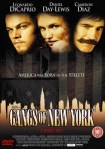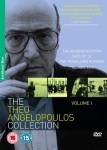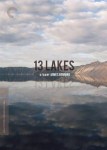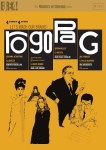Still trying to to catch up… Half of the films in this post’s half-dozen are from the US, but only one of them is an actual feature film per se. Both Benning’s and Baillie’s work are better considered art, or video installations – a form of art I especially like. The remaining films are an odd mix – one I expected to like but didn’t, one turned out to be a lot better than expected, and one wasn’t quite as interesting as I’d hope although still quite good.
 Gangs of New York*, Martin Scorsese (2002, USA). If Terrence Malick is the nearest Hollywood has produced to an actual auteur, then Scorsese, although a resolutely commercial director, is perhaps closest in Hollywood to him. Personally, I find Scorsese’s films well-made but over-rated; but he has the advantage of a career pretty much explicitly laid out in the films he’s directed, all of which are still readily available in a format of your choice. Gangs of New York was a commercial success, and a critical one too – not just appearing on the 1001 Movies You Must See Before You Die list, but also nominated for a shedload of Oscars, BAFTAs, Gold Globes and assorted other film awards (although it won no Oscars, Day-Lewis got best actor BAFTA, and Scorsese won best director Golden Globe). The story is set in New York during the 1840s to the 1860s. The film opens with a pitched – and gory – battle between the Irish immigrants and the native New Yorkers (of course, they’re all immigrants, the so-called “natives” arrived a couple of generations earlier). The movie then follows Amsterdam, son of the murdered leader of the Irish faction, and played by Leonardo di Caprio, as he returns to New York as a young man and goes to work for leader of the natives, Cutting, played by Daniel Day-Lewis. The film is apparently historically accurate, even down to the accent used by Day-Lewis and others, and it’s pretty gruesome stuff. Quite how the US built a reputation as the Land of the Free and the Land of Opportunity when its biggest city was a cesspit of violence and corruption is a mystery. But then you have the myth of the wide open spaces of the Wild West, when it was all land stolen from the Native Americans, and those who stole it were mostly as violent and venal as the worst criminals. That was all pretty much around the same time. And not so long ago. Mind you, Dickens’s England was no less grim a place. Although it does seem a little like the new governments of both the UK and USA are determined to return us to those days…
Gangs of New York*, Martin Scorsese (2002, USA). If Terrence Malick is the nearest Hollywood has produced to an actual auteur, then Scorsese, although a resolutely commercial director, is perhaps closest in Hollywood to him. Personally, I find Scorsese’s films well-made but over-rated; but he has the advantage of a career pretty much explicitly laid out in the films he’s directed, all of which are still readily available in a format of your choice. Gangs of New York was a commercial success, and a critical one too – not just appearing on the 1001 Movies You Must See Before You Die list, but also nominated for a shedload of Oscars, BAFTAs, Gold Globes and assorted other film awards (although it won no Oscars, Day-Lewis got best actor BAFTA, and Scorsese won best director Golden Globe). The story is set in New York during the 1840s to the 1860s. The film opens with a pitched – and gory – battle between the Irish immigrants and the native New Yorkers (of course, they’re all immigrants, the so-called “natives” arrived a couple of generations earlier). The movie then follows Amsterdam, son of the murdered leader of the Irish faction, and played by Leonardo di Caprio, as he returns to New York as a young man and goes to work for leader of the natives, Cutting, played by Daniel Day-Lewis. The film is apparently historically accurate, even down to the accent used by Day-Lewis and others, and it’s pretty gruesome stuff. Quite how the US built a reputation as the Land of the Free and the Land of Opportunity when its biggest city was a cesspit of violence and corruption is a mystery. But then you have the myth of the wide open spaces of the Wild West, when it was all land stolen from the Native Americans, and those who stole it were mostly as violent and venal as the worst criminals. That was all pretty much around the same time. And not so long ago. Mind you, Dickens’s England was no less grim a place. Although it does seem a little like the new governments of both the UK and USA are determined to return us to those days…
 Holy Motors, Leos Carax (2012, France). This film had all the ingredients which should have led to me loving it, but for some reason it never quite worked for me. The story is enigmatic, very little is explained, in fact it’s more of an anthology than a single plot, the cinematography is excellent, and the cast are very good too… But the whole thing felt like a film-making exercise to me, and only more so when I learnt that one of the longest segments is based on a short film made by Carax four years earlier. I’ve heard Holy Motors described as an anthology film, deliberately broken down into more easily-digestible chunks to prove a point about art house cinema, but I’m not sure I buy it. The celebrity cameos seem to suggest a personal project from a director with more of a reputation than his oeuvre suggests. Eve Mendes, for example, plays a model abudcted by Mr Merde and says nothing during her part in the film. Kylie Minogue plays a colleague of the main character, and ends up singing a really quite awful song that can’t decide if it belongs in a Broadway musical or a rock jukebox musical. The framing narrative doesn’t explain the individual segments, only links them. And while the cinematography is excellent, as is the cast, the story is enigmatic to the point of nonsense – the segment in which the protagonist – well, a cleverly-disguised stunt double – does a motion-capture sequence for an ugly CGI sequence of two great wyrms mating is entirely meaningless. That this is later followed by a sequence in which a father picks up his teenage daughter from a party, only to learn she hid in the bathroom because she’s afraid of not being popular… it shows only that the guiding principle here is directorial whim. There’s no pattern, no story-arc, no point. There’s only a director who feels like he’s not in control of his creative process – and, though I’m only going on the one film I’ve seen by Carax, he strikes me as someone who may one day make a great movie… but Holy Motors is not it.
Holy Motors, Leos Carax (2012, France). This film had all the ingredients which should have led to me loving it, but for some reason it never quite worked for me. The story is enigmatic, very little is explained, in fact it’s more of an anthology than a single plot, the cinematography is excellent, and the cast are very good too… But the whole thing felt like a film-making exercise to me, and only more so when I learnt that one of the longest segments is based on a short film made by Carax four years earlier. I’ve heard Holy Motors described as an anthology film, deliberately broken down into more easily-digestible chunks to prove a point about art house cinema, but I’m not sure I buy it. The celebrity cameos seem to suggest a personal project from a director with more of a reputation than his oeuvre suggests. Eve Mendes, for example, plays a model abudcted by Mr Merde and says nothing during her part in the film. Kylie Minogue plays a colleague of the main character, and ends up singing a really quite awful song that can’t decide if it belongs in a Broadway musical or a rock jukebox musical. The framing narrative doesn’t explain the individual segments, only links them. And while the cinematography is excellent, as is the cast, the story is enigmatic to the point of nonsense – the segment in which the protagonist – well, a cleverly-disguised stunt double – does a motion-capture sequence for an ugly CGI sequence of two great wyrms mating is entirely meaningless. That this is later followed by a sequence in which a father picks up his teenage daughter from a party, only to learn she hid in the bathroom because she’s afraid of not being popular… it shows only that the guiding principle here is directorial whim. There’s no pattern, no story-arc, no point. There’s only a director who feels like he’s not in control of his creative process – and, though I’m only going on the one film I’ve seen by Carax, he strikes me as someone who may one day make a great movie… but Holy Motors is not it.
 The Travelling Players*, Theodoros Angelopoulos (1975, Greece). I’ve been aware of Angelopoulos for a couple of years, although I’ve never previously seen any of his films nor had much of an idea what his films were like. But The Travelling Players eventually worked its way to the top of the rental list and was duly sent to me and… One thing I hadn’t known about Angelopoulos is that his films tick a lot of my boxes: long static shots, declamatory dialogue, plots that cover decades… This is stuff that I love in films, and apparently The Travelling Players is not unique in Angelopoulos’s oeuvre in doing so. The Travelling Players is currently available as a part of a box set, so I think I’ll be getting the box set. But, The Travelling Players… It’s about a troupe of actors, who travel the country with a play about Golfo the Shepherdess, between 1939 and 1952. As well as the covering the events in Greece during that time – the invasion by the Nazis, the war between the fascists and the communists, the British and US occupations, the Regime of the Colonels… – but the troupe’s internal dynamics are all based on the story of the House of Atreus. There are parts of the the film where a character talks directly to camera. There are some frankly bizarre scenes, like the British platoon forcing the troupe to perform on a beach, only to end up dancing with each other, or the dance hall where the fascists and communists clash like the Jets and the Sharks… The Travelling Players is also a very long film, clocking in at 230 minutes; but it’s fascinating throughout. Angelopoulos’s name was not unknown to me, but until now I’d not seen any of his films. Having seen The Travelling Players, I plan to explore his oeuvre. Recommended.
The Travelling Players*, Theodoros Angelopoulos (1975, Greece). I’ve been aware of Angelopoulos for a couple of years, although I’ve never previously seen any of his films nor had much of an idea what his films were like. But The Travelling Players eventually worked its way to the top of the rental list and was duly sent to me and… One thing I hadn’t known about Angelopoulos is that his films tick a lot of my boxes: long static shots, declamatory dialogue, plots that cover decades… This is stuff that I love in films, and apparently The Travelling Players is not unique in Angelopoulos’s oeuvre in doing so. The Travelling Players is currently available as a part of a box set, so I think I’ll be getting the box set. But, The Travelling Players… It’s about a troupe of actors, who travel the country with a play about Golfo the Shepherdess, between 1939 and 1952. As well as the covering the events in Greece during that time – the invasion by the Nazis, the war between the fascists and the communists, the British and US occupations, the Regime of the Colonels… – but the troupe’s internal dynamics are all based on the story of the House of Atreus. There are parts of the the film where a character talks directly to camera. There are some frankly bizarre scenes, like the British platoon forcing the troupe to perform on a beach, only to end up dancing with each other, or the dance hall where the fascists and communists clash like the Jets and the Sharks… The Travelling Players is also a very long film, clocking in at 230 minutes; but it’s fascinating throughout. Angelopoulos’s name was not unknown to me, but until now I’d not seen any of his films. Having seen The Travelling Players, I plan to explore his oeuvre. Recommended.
 Volume 1: Five Collected Films by Bruce Baillie (1964-1968, USA). I stumbled across mention of Baillie’s All My Life on a list of best films somewhere, and found a copy of it on Youtube (it’s only 2 minutes and 45 seconds long, but it is quite excellent – see here). So I did a little more research, and learnt that Baillie is best-remembered for Castro Street, a short film from 1966. Canyon Cinema, a collective he helped found, released some of his films on DVD, but they appear to have sold out. Fortunately, they’re available on Youtube in HD, including this collection, which contains Tung, Mass (for the Lakota Sioux), Valentin de las Sierras, Castro Street and All My Life. The first three are experimental/avant garde cinema, and middling successful, but Castro Street, a montage of industrial plants on the titular street, is fully deserving of its high reputation; and even In My Life, which is 3 minutes of Ella Fitzgerald singing as Baillie pans a camera along a fence, hs a beauty all its own. I discovered Baillie by accident, but it turns out to have been a happy one. I won’t be forgetting him.
Volume 1: Five Collected Films by Bruce Baillie (1964-1968, USA). I stumbled across mention of Baillie’s All My Life on a list of best films somewhere, and found a copy of it on Youtube (it’s only 2 minutes and 45 seconds long, but it is quite excellent – see here). So I did a little more research, and learnt that Baillie is best-remembered for Castro Street, a short film from 1966. Canyon Cinema, a collective he helped found, released some of his films on DVD, but they appear to have sold out. Fortunately, they’re available on Youtube in HD, including this collection, which contains Tung, Mass (for the Lakota Sioux), Valentin de las Sierras, Castro Street and All My Life. The first three are experimental/avant garde cinema, and middling successful, but Castro Street, a montage of industrial plants on the titular street, is fully deserving of its high reputation; and even In My Life, which is 3 minutes of Ella Fitzgerald singing as Baillie pans a camera along a fence, hs a beauty all its own. I discovered Baillie by accident, but it turns out to have been a happy one. I won’t be forgetting him.
 13 Lakes, small roads and Easy Rider, James Benning (2004/2011/2012, USA). I’ve made no secret of my admiration for James Benning’s work, and while I have everything he has so far released on DVD through the Österreichesches Filmmuseum, one of his best-known works, 13 Lakes, is still unavailable from them. Fortunately, someone has loaded it up onto Youtube, although it’s not a brilliant transfer. And since I’d figured out how to watch Youtube using the app on on my telly via Amazon Prime, I used it to watch 13 Lakes. Benning’s titles tend to the literal, so 13 Lakes is indeed about thirteen lakes, each of which is filmed from a static position for ten minutes. That’s it. The shots are framed such that water fills the bottom half of the screen and sky the top half. Whatever happens while the camera is running, is captured; and the soundtrack is entirely ambient sound. I happen to think Benning is a genius, and while he does really interesting things with narrative in Deseret, American Dreams (lost and found) and Landscape Suicide, other films such as RR and the California Trilogy are more in the nature of video installations. As is 13 Lakes. So he presses lots of buttons for me. Small roads is more of the same, static shots of minor roads in the US, each shot a couple of minutes long and the soundtrack composed entirely of ambient sound. Unlike in 13 Lakes, the screen is not split in two, in fact the proportion of land to sky increases as the film progresses. It is mesmerising, despite the lack of narrative. Easy Rider, however, is something different. Benning retraced the route taken by the actors in Dennis Hopper’s Easy Rider, but focused his camera on the landscape. He uses the soundtrack of the film – some music, some dialogue – but other times relies on ambient sound. What I especially like about Benning is that he’s mythologizing the landscape of the North American continent using the artefacts of its current colonising culture. Not entirely, of course – Four Corners covers Native American cave art, after all. But Deseret explicitly charts the impact of people on the Utah landscape, and while 13 Lakes shows the transient nature of the marks humanity makes on a body of water (the wake of a boat or jetski, soon erased), small roads documents a more permanent marker on the landscape: tarmac. And Easy Rider ties the landscape directly to a cultural object, the story of a feature film, a fiction. I would dearly love to have copies of all of Benning’s films, but sadly only a few have been released on DVD. Equally sadly, I do not live in a city with a world-renowned modern art museum that is likely to exhibit his work. (I do, however, live in a city with Curzon cinema, but even that means nothing – as Curzon, in all their wisdom, have so far chosen not to show Sokurov’s Francofonia here, but only in their London venues. Bah.)
13 Lakes, small roads and Easy Rider, James Benning (2004/2011/2012, USA). I’ve made no secret of my admiration for James Benning’s work, and while I have everything he has so far released on DVD through the Österreichesches Filmmuseum, one of his best-known works, 13 Lakes, is still unavailable from them. Fortunately, someone has loaded it up onto Youtube, although it’s not a brilliant transfer. And since I’d figured out how to watch Youtube using the app on on my telly via Amazon Prime, I used it to watch 13 Lakes. Benning’s titles tend to the literal, so 13 Lakes is indeed about thirteen lakes, each of which is filmed from a static position for ten minutes. That’s it. The shots are framed such that water fills the bottom half of the screen and sky the top half. Whatever happens while the camera is running, is captured; and the soundtrack is entirely ambient sound. I happen to think Benning is a genius, and while he does really interesting things with narrative in Deseret, American Dreams (lost and found) and Landscape Suicide, other films such as RR and the California Trilogy are more in the nature of video installations. As is 13 Lakes. So he presses lots of buttons for me. Small roads is more of the same, static shots of minor roads in the US, each shot a couple of minutes long and the soundtrack composed entirely of ambient sound. Unlike in 13 Lakes, the screen is not split in two, in fact the proportion of land to sky increases as the film progresses. It is mesmerising, despite the lack of narrative. Easy Rider, however, is something different. Benning retraced the route taken by the actors in Dennis Hopper’s Easy Rider, but focused his camera on the landscape. He uses the soundtrack of the film – some music, some dialogue – but other times relies on ambient sound. What I especially like about Benning is that he’s mythologizing the landscape of the North American continent using the artefacts of its current colonising culture. Not entirely, of course – Four Corners covers Native American cave art, after all. But Deseret explicitly charts the impact of people on the Utah landscape, and while 13 Lakes shows the transient nature of the marks humanity makes on a body of water (the wake of a boat or jetski, soon erased), small roads documents a more permanent marker on the landscape: tarmac. And Easy Rider ties the landscape directly to a cultural object, the story of a feature film, a fiction. I would dearly love to have copies of all of Benning’s films, but sadly only a few have been released on DVD. Equally sadly, I do not live in a city with a world-renowned modern art museum that is likely to exhibit his work. (I do, however, live in a city with Curzon cinema, but even that means nothing – as Curzon, in all their wisdom, have so far chosen not to show Sokurov’s Francofonia here, but only in their London venues. Bah.)
 Let’s Wash Our Brains: RoGoPaG, Rossellini, Godard, Pasolini, Gregoretti (1963, Italy). Alfredo Bini apparently had the bright idea of putting together an anthology film comprising four shorts from well-known directors, although I’ve no idea if the concept was as commerically viable back then as it is now – ie, not at all. It’s not like this was the only example – there’s films such as Le Bambole from 1965, for example. Certainly RoGoPaG had a better line-up of directors… but given how little your average audience cares about who directs a film – many lists of best films don’t even name the director, for instance – it’s arguable how relevant that is. In the event, we get four short films that are emblematic – perhaps too much so – of the four directors’ works, without being their best work. Roberto Rossellini provides a story about an air stewardess who attracts the unwelcome attentions of an American who flies her route – to Bangkok – and who she decides to repel by acting more seucally-liberated than she actually is. It’s a thin piece, and it hard to work out what the point of it all is. Godard provides the second part, a five-finger exercise based on the thinnest of plots: a nuclear bomb has exploded near Paris, and two young actors get to practice acting exercises as a response to the explosion. The third film is by Pier Paolo Pasolini and is easily the best of the four. Orson Welles is making afilm about the Crucifixion, although he actually appears to be re-staging in real life famous paintings of the Crucifuxion. One of the extras has not eaten for a while and spends the entire film trying to find something to eat – to his eventual detriment. The humour is broad, the acting broader, Welles looks the part but is dubbed so he doesn’t sound it, and the re-enactments of the Crucifixion are quite astonishingly effective. The final film is the most traditional, and tells a straightforward story of a middle-class Italian family looking to upgrade their home by buying a plot of land on a future development. The kids spout advertising slogans, the family are clearly victims of consumer culture, and their final realisation of their situation is rewarded with an undeserved death. Despite the names attached to RoGoPaG, I suspect Bini thought he had something weightier on his hands than he actually had. The Pasolini apparently caused a bit of a fuss on release, though it seems tame stuff these days to non-Catholic eyes. I’m still not entirely sure what purpose anthology films served, or why anyone ever bothered to make them. I suspect they were mostly vanity projects for producers – “hey, I got to work with Rossellini, Godard, Pasolini and, er, Gregoretti!” – but they’re certainly an odd fit in the world of twenty-first century cinema.
Let’s Wash Our Brains: RoGoPaG, Rossellini, Godard, Pasolini, Gregoretti (1963, Italy). Alfredo Bini apparently had the bright idea of putting together an anthology film comprising four shorts from well-known directors, although I’ve no idea if the concept was as commerically viable back then as it is now – ie, not at all. It’s not like this was the only example – there’s films such as Le Bambole from 1965, for example. Certainly RoGoPaG had a better line-up of directors… but given how little your average audience cares about who directs a film – many lists of best films don’t even name the director, for instance – it’s arguable how relevant that is. In the event, we get four short films that are emblematic – perhaps too much so – of the four directors’ works, without being their best work. Roberto Rossellini provides a story about an air stewardess who attracts the unwelcome attentions of an American who flies her route – to Bangkok – and who she decides to repel by acting more seucally-liberated than she actually is. It’s a thin piece, and it hard to work out what the point of it all is. Godard provides the second part, a five-finger exercise based on the thinnest of plots: a nuclear bomb has exploded near Paris, and two young actors get to practice acting exercises as a response to the explosion. The third film is by Pier Paolo Pasolini and is easily the best of the four. Orson Welles is making afilm about the Crucifixion, although he actually appears to be re-staging in real life famous paintings of the Crucifuxion. One of the extras has not eaten for a while and spends the entire film trying to find something to eat – to his eventual detriment. The humour is broad, the acting broader, Welles looks the part but is dubbed so he doesn’t sound it, and the re-enactments of the Crucifixion are quite astonishingly effective. The final film is the most traditional, and tells a straightforward story of a middle-class Italian family looking to upgrade their home by buying a plot of land on a future development. The kids spout advertising slogans, the family are clearly victims of consumer culture, and their final realisation of their situation is rewarded with an undeserved death. Despite the names attached to RoGoPaG, I suspect Bini thought he had something weightier on his hands than he actually had. The Pasolini apparently caused a bit of a fuss on release, though it seems tame stuff these days to non-Catholic eyes. I’m still not entirely sure what purpose anthology films served, or why anyone ever bothered to make them. I suspect they were mostly vanity projects for producers – “hey, I got to work with Rossellini, Godard, Pasolini and, er, Gregoretti!” – but they’re certainly an odd fit in the world of twenty-first century cinema.
1001 Movies You Must See Before You Die count: 831
